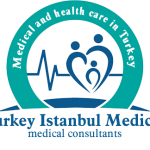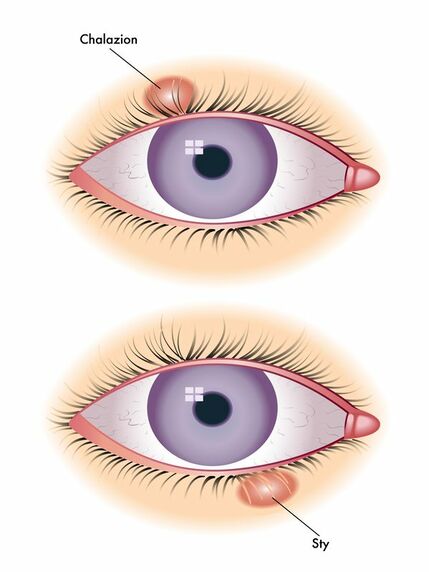What is a Stye (Hordeolum) and Chalazion (Eyelid Cyst)?
Stye (Hordeolum)
A stye (Medical Name: Hordeolum) is a red, painful swelling that develops at the base of the eyelash or on the eyelid. It usually develops as a result of bacterial infection. It is more common in people with eyelid inflammation (blepharitis). There are two types.
-
Internal Stye:
It is rarer. It is inside the eyelid. And it usually occurs as a result of bacterial infection of the sebaceous glands.
-
External Stye:
This type is most common. It is a bacterial infection that occurs in the root of the hair. It looks like acne. There is pain, tenderness and swelling.
Chalazion(Eyelid Cyst)
Chalazion are small swellings caused by the obstruction or inflammation of the sebaceous glands (meibomian glands) in the eyelid. These swellings in the eyes are usually filled with fat deposits that cannot be discharged due to obstruction or inflammations from infections. Chalazion structures can occur on the inside or outside of the eyelid.
It may cause complaints such as redness, swelling, stinging sensation. In addition, temporary astigmatism or blurred vision may occur as a result of the pressure of the chalazion cyst. Most cases of chalazion do not persist for more than a few weeks and will heal on their own without any treatment. However, for cases that last longer than a few weeks and do not heal spontaneously, it may be necessary to take advantage of surgical procedures to relieve the congestion in the eyelid glands.
What is the Cause of Stye (Hordeolum) and Chalazion (Eyelid Cyst)?
The formation of a sty is caused by a bacterial infection. The bacteria usually grows in the root of the eyelash (follicle). Eyelid gland inflammation is caused by an infection in the small oil glands inside the eyelid.
Chalazion occurs when the summer glands in the eyelid become clogged. If the inflammation of the eyelid gland does not drain or heal, it can turn into a chalazion.
What is the Difference Between a Stye (Hordeolum) and Chalazion (Eyelid Cyst)?
It can sometimes be difficult to distinguish a Stye from a chalazion.
A stye : is very painful. It usually occurs at the edge of the eyelid and is caused by an inflamed eyelash root. It usually swells and sometimes affects the entire eyelid.
A chalazion : is not usually painful. It is a lump that develops behind the eyelid rather than a stye. It is caused by a clogged sebaceous gland. And it is rare for it to cause swelling of the entire eyelid.
What Are the Symptoms of Stye (Hordeolum) and Chalazion (Eyelid Cyst)?
A stye usually starts with a red bump on the eyelid that looks like a pimple.
- As the stye grows, the eyelid begins to swell and become painful, and there may be watering in the eye.
- Most Styes swell three days before they burst and flow.
- Styes usually heal within a week.
A chalazion occurs as a hard swelling or cyst under the skin of the eyelid.
- Chalazion grows slower than a stye. If it gets big enough, it can block the view.
- Inflammation and swelling may spread and cover the eye area.
- The chalazion usually goes away within a few weeks without treatment.
Whose Stye and Chalazion Are More Seen?
These diseases can happen to anyone.
But;
- Eyelid inflammation
- Skin diseases such as acne rosacea or seborrheic dermatitis
- Oily skin structure
- Previous sty and chalazion
more common in such cases. Apart from these, reasons such as rubbing the eyes too often, wearing and removing contact lenses without washing hands, and sleeping without removing eye make-up increase the risk of developing these diseases.
How Is a Stye (Hordeolum) and Chalazion (Eyelid Cyst) Diagnosed?
The doctor will diagnose a sty or chalazion by carefully examining the eyelid. It can be difficult to distinguish the difference between a sty and a chalazion. If there is a hard swelling inside the eyelid, the doctor will likely diagnose a chalazion.
How to Treat Stye and Chalazion?
Especially since the appearance of the stye resembles a pimple, it is sometimes tried to be popped by the patients. This should never be done, otherwise the infection may spread to the eyelid and cause more serious problems.
-
Stye:
-
Often No Treatment Required;
Because the tip of most styes will burst and discharge spontaneously within 3-4 days.
-
Warm Dressing;
It will reduce pain and help the inflammation collect at the tip of the stye and burst and flow out. Make-up and contact lenses are suspended.
-
Eyelash Epilation;
If the patient has an external sty, the affected eyelash is pulled. Thus, the focus of infection is eliminated and the inflammation is drained.
-
The Front Sight is Emptied;
It should be done by an ophthalmologist. A small incision is made at the tip of the stye and the sty is pressed to allow the inflammation to flow. You should definitely not do it yourself, otherwise you may cause the infection to spread to the eyelid.
-
Drops Containing Antibiotic and Cortisone;
They help control infection and reduce inflammation. It is used as recommended by your doctor.
-
Antibiotic Pill;
Most of the time it is not necessary. If the infection has spread to the skin, it may rarely be needed to control it.
-
Often No Treatment Required;
It resolves spontaneously in half of the patients. This can take 2-6 months. If it does not cause any discomfort to the patient, it can be expected without treatment.
-
Warm Dressing;
It reduces complaints such as pain, redness, swelling. It makes the solidified fluid in the cyst fluid and may facilitate its evacuation.
-
Massage;
Massaging the cyst after the warm dressing facilitates the discharge of the cyst.
-
Antibiotic Drops;
Since there is no infection in chalazion, it does not need to be used.
-
Operation;
If the chalazion does not improve despite all treatments, or if it puts pressure on the eye and causes visual impairment, it should be surgically removed. With a small incision on the inside of the eyelid, the cyst is drained and cleaned.

